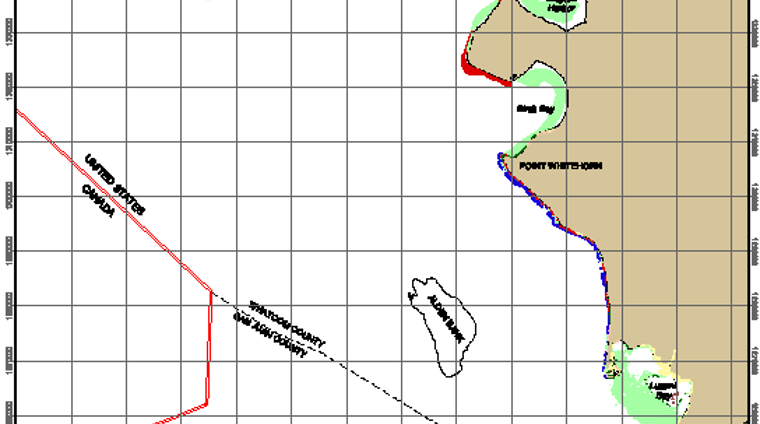Bull Kelp
Bull kelp is best known for the long, smooth, brown bull whips that wash up on beaches in fall and winter. This long stipe, or stalk, leads on one end to a bulbous gas float, attached to long, flat, leaf-like blades. At the other end of the stipe is a holdfast - a disc-shaped, root-like structure that adheres to rocky substrates at depths to 60 feet. Boaters know kelp for the dense floating beds that mark shallow rocks and reefs.
Photo Credit: Jim Ramaglia
Distribution
Kelp is found on the Pacific Coast from Southern California to Alaska's Aleutian Islands, thriving in the turbid subtidal waters of ocean coasts and straits. More versatile than the perennial giant kelp of rocky ocean shorelines, bull kelp grows on substrates cobble of in Puget Sound and on boulders and rock in the straits. In Whatcom County, bull kelp is most typically found along the Cherry Point reach.


Life cycle
The fastest growing seaweed in the world, Bull kelp can grow from a tiny spore to a 120-foot adult mature plant in a single season. Although in Puget Sound waters, bull kelp will typically just reach 30 feet in length. On the blades of mature kelp spore-forming patches, called sori, develop and sluff off, leaving holes or notches in aging blades. These heavy patches often fall near the parent's base, but some may drift far to release their spores in new territories. Kelp typically break off from their holdfast during fall storms, die and wash up onto beaches, ending their life after just one season.
Ecology
Large kelp forests provide structure for a wide variety of sea creatures. Small crustaceans called isopods feed directly on the blades, while other types of plankton prosper in the waters calmed by the thick kelp stands. The abundant food and shelter from predators make kelp communities valuable habitat for juvenile salmon, rockfish and surf smelt. Herring that spawn along Cherry Point are unique in their use of bull kelp as a spawning surface.
The calmed waters of the kelp beds serve as refuges for seabirds such as ducks, grebes and gulls which also take advantage of the food reserves within. At the base, kelp holdfasts and other algae form a diverse understory with urchin, shrimp, fish and other creatures. Particles sloughed off the decaying ends of kelp blades provide a valuable food source for filter feeders like Pacific blue mussels. In addition, masses of dead kelp washed ashore provide food and shelter for communities of scavengers like crabs and beach hoppers, which are food for shorebirds and other life.
Economic Value
Kelp does not recover well from harvest so kelp is protected from collection in the Puget Sound. An important economic value of kelp forests in Whatcom County has been the habitat provided for salmon, herring and other forage fish, which have been commercially harvested.
Current Status
While Kelp forests are gaining recognition for their importance as habitat to fish and wildlife, they are also now being recognized for their role in reducing beach erosion by softening the impact of waves on shorelines. Overall, the population of bull kelp in Whatcom County appears to be stable, but locally, kelp forests may be impacted different ways:
Petroleum products are toxic to kelp, particularly diesel and fuel oil. Creatures of kelp forests can be repeatedly contaminated by spilt oil trapped among the floating fronds. Dredging and construction activities can remove plants. Damage to the stipe, such as by a boat or anchor, can cause the kelp to break off or sink.
Sources
- O'Clair & Lindstrom, North Pacific Seaweeds. (2000)
- Washington Department of Natural Resources
- Washington Department of Ecology
- Ann Shaffer (WDFW). Kelp bed habitats of the inland waters of Western Washington. (1998)
- Ann Shaffer (WDFW). Preferential use of nearshore kelp habitats by juvenile salmon and forage fish. (2003)
- Dan Pentilla (WDFW), personal communication.